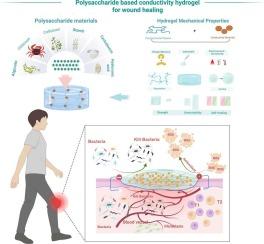Recent developments in polysaccharide-based conductive hydrogels: A review and perspective
IF 12.5
1区 化学
Q1 CHEMISTRY, APPLIED
引用次数: 0
Abstract
Polysaccharides, as naturally occurring, bioactive, and environmentally degradable polymers, have garnered increasing attention in the development of hydrogel materials. Their remarkable electrical conductivity and outstanding biocompatibility have led to numerous applications for polysaccharide-derived conductive hydrogels in the field of wound healing. This review highlights recent advancements in this area, beginning with an overview of polysaccharide-based conductive hydrogel materials, which include chitosan-based, cellulose-based, starch-based, cyclodextrin-based, alginate-based, and hyaluronic acid-based conductive hydrogels. Furthermore, the review discusses the key characteristics of these hydrogels. Representative applications of polysaccharide-based conductive hydrogels at various stages of wound healing are summarized, including antibacterial effects during the inflammatory phase, promotion of cell migration and proliferation, and applications in scar repair. Finally, the review addresses current challenges and provides guidance for future research, aiming to advance the field of polysaccharide-based conductive hydrogels in wound healing.

多糖基导电水凝胶研究进展综述与展望
多糖作为天然存在的、具有生物活性和环境可降解的聚合物,在水凝胶材料的开发中越来越受到关注。它们卓越的导电性和出色的生物相容性使多糖衍生的导电水凝胶在伤口愈合领域得到了许多应用。本文综述了该领域的最新进展,首先概述了基于多糖的导电水凝胶材料,包括基于壳聚糖的、基于纤维素的、基于淀粉的、基于环糊精的、基于海藻酸盐的和基于透明质酸的导电水凝胶。此外,还讨论了这些水凝胶的主要特性。本文综述了多糖基导电水凝胶在伤口愈合各个阶段的代表性应用,包括炎症期的抗菌作用,促进细胞迁移和增殖,以及在疤痕修复中的应用。最后,综述了当前面临的挑战,并为未来的研究提供了指导,旨在推动多糖基导电水凝胶在伤口愈合领域的发展。
本文章由计算机程序翻译,如有差异,请以英文原文为准。
求助全文
约1分钟内获得全文
求助全文
来源期刊

Carbohydrate Polymers
化学-高分子科学
CiteScore
22.40
自引率
8.00%
发文量
1286
审稿时长
47 days
期刊介绍:
Carbohydrate Polymers stands as a prominent journal in the glycoscience field, dedicated to exploring and harnessing the potential of polysaccharides with applications spanning bioenergy, bioplastics, biomaterials, biorefining, chemistry, drug delivery, food, health, nanotechnology, packaging, paper, pharmaceuticals, medicine, oil recovery, textiles, tissue engineering, wood, and various aspects of glycoscience.
The journal emphasizes the central role of well-characterized carbohydrate polymers, highlighting their significance as the primary focus rather than a peripheral topic. Each paper must prominently feature at least one named carbohydrate polymer, evident in both citation and title, with a commitment to innovative research that advances scientific knowledge.
 求助内容:
求助内容: 应助结果提醒方式:
应助结果提醒方式:


